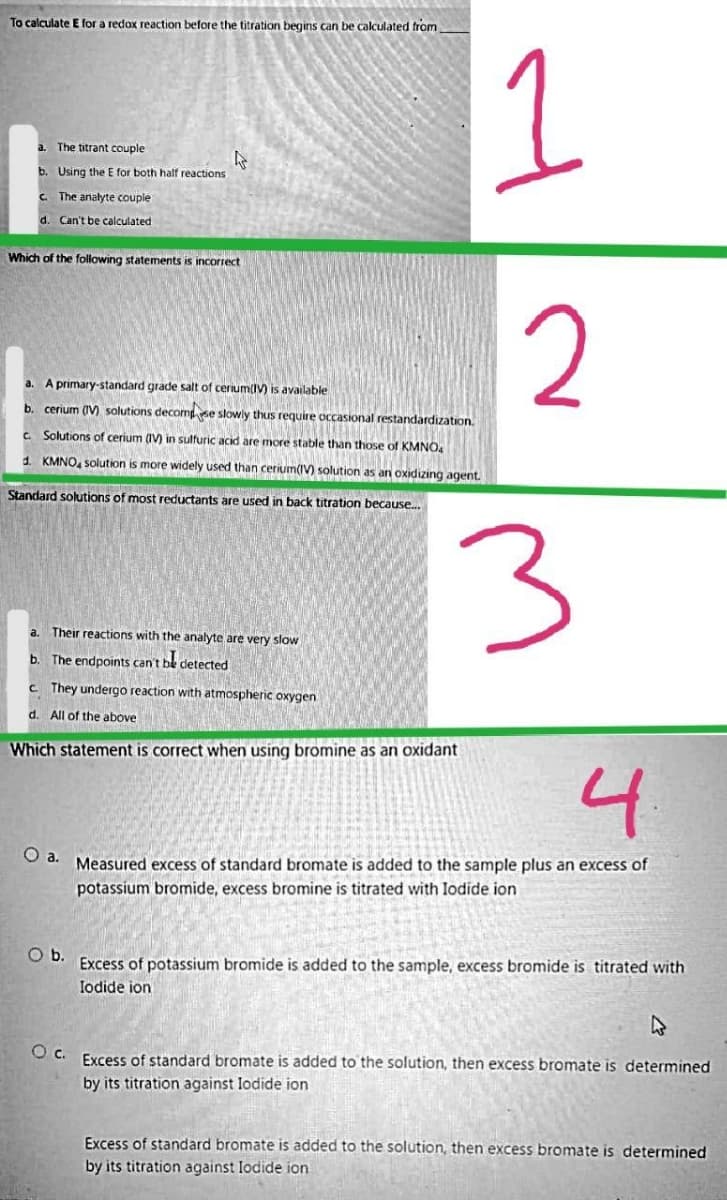To calculate E for a redax reaction before the titration begins can be calculated from a. The titrant couple b. Using the E for both half reactions C The analyte couple d. Can't be calculated
To calculate E for a redax reaction before the titration begins can be calculated from a. The titrant couple b. Using the E for both half reactions C The analyte couple d. Can't be calculated
Principles of Instrumental Analysis
7th Edition
ISBN:9781305577213
Author:Douglas A. Skoog, F. James Holler, Stanley R. Crouch
Publisher:Douglas A. Skoog, F. James Holler, Stanley R. Crouch
Chapter24: Coulometry
Section: Chapter Questions
Problem 24.4QAP: Halide ions can he deposited at a silver anode, the reaction being Ag(s) + X- AgX(s) +e- Suppose...
Related questions
Question
6

Transcribed Image Text:To calculate E for a redox reaction before the titration begins can be calculated from
1.
a. The titrant couple
b. Using the E for both half reactions
C. The analyte couple
d. Can't be calculated
Which of the following statements is incorrect
2
a. A primary-standard grade salt of cerium(IV) is available
b. cerium (IVM solutions decompse slowly thus require occasional restandardization.
c. Solutions of cerium (IV) in sulfuric acid are more stable than those of KMNO.
d.
solution is more widely used than cerium(IV) solution as an oxidizing agent.
Standard solutions of most reductants are used in back titration because.
a.
Their reactions with the analyte are very slow
b. The endpoints can't be detected
C They undergo reaction with atmospheric oxygen
d. All of the above
Which statement is correct when using bromine as an oxidant
O a. Measured excess of standard bromate is added to the sample plus an excess of
potassium bromide, excess bromine is titrated with Iodide ion
Ob.
Excess of potassium bromide is added to the sample, excess bromide is titrated with
Iodide ion
O C. Excess of standard bromate is added to the solution, then excess bromate is determined
by its titration against lodide ion
Excess of standard bromate is added to the solution, then excess bromate is determined
by its titration against Iodide ion
Expert Solution
This question has been solved!
Explore an expertly crafted, step-by-step solution for a thorough understanding of key concepts.
Step by step
Solved in 2 steps

Knowledge Booster
Learn more about
Need a deep-dive on the concept behind this application? Look no further. Learn more about this topic, chemistry and related others by exploring similar questions and additional content below.Recommended textbooks for you

Principles of Instrumental Analysis
Chemistry
ISBN:
9781305577213
Author:
Douglas A. Skoog, F. James Holler, Stanley R. Crouch
Publisher:
Cengage Learning

Chemistry: An Atoms First Approach
Chemistry
ISBN:
9781305079243
Author:
Steven S. Zumdahl, Susan A. Zumdahl
Publisher:
Cengage Learning


Principles of Instrumental Analysis
Chemistry
ISBN:
9781305577213
Author:
Douglas A. Skoog, F. James Holler, Stanley R. Crouch
Publisher:
Cengage Learning

Chemistry: An Atoms First Approach
Chemistry
ISBN:
9781305079243
Author:
Steven S. Zumdahl, Susan A. Zumdahl
Publisher:
Cengage Learning


Chemistry
Chemistry
ISBN:
9781305957404
Author:
Steven S. Zumdahl, Susan A. Zumdahl, Donald J. DeCoste
Publisher:
Cengage Learning

Chemical Principles in the Laboratory
Chemistry
ISBN:
9781305264434
Author:
Emil Slowinski, Wayne C. Wolsey, Robert Rossi
Publisher:
Brooks Cole
